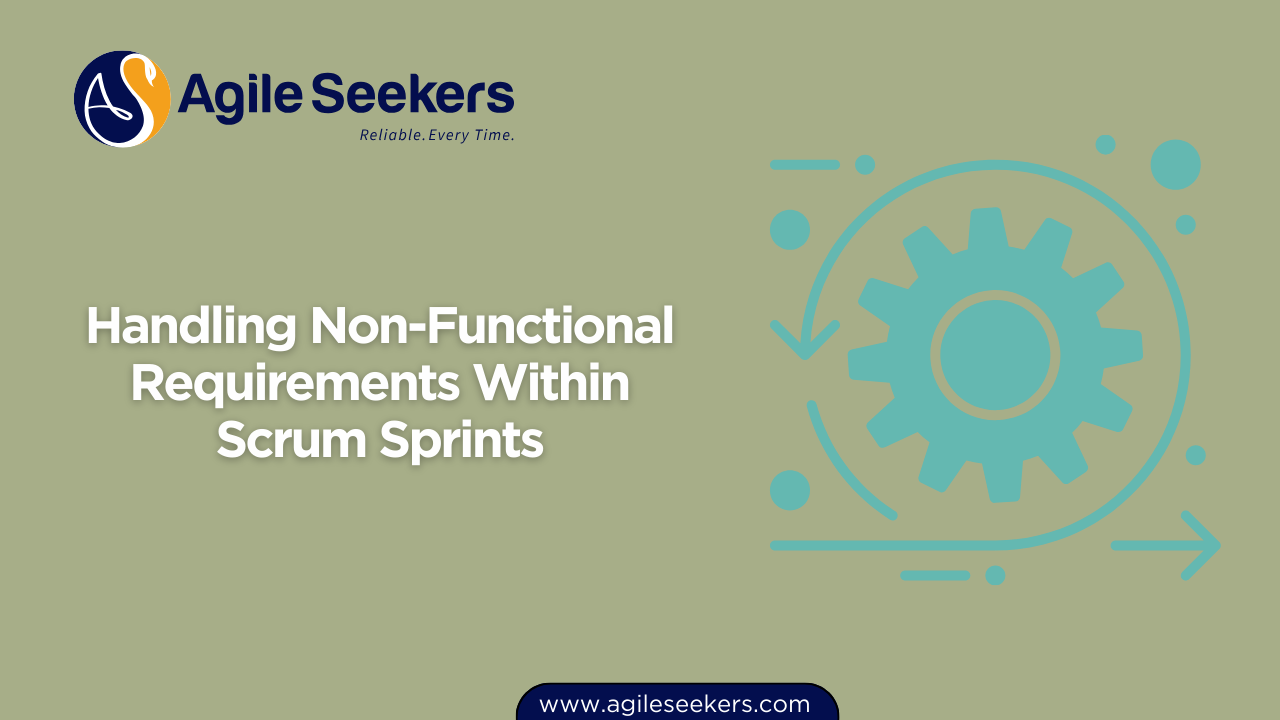Handling Non-Functional Requirements Within Scrum Sprints

Non-functional requirements (NFRs) like performance, security, scalability, and availability don’t usually make headlines in the product backlog. Yet, they can silently break a sprint, disrupt releases, and increase technical debt if ignored. For Scrum teams striving for high-quality, user-focused delivery, handling NFRs within sprints is not optional—it’s essential.
In this post, we’ll explore how Scrum teams can integrate non-functional requirements directly into sprint planning and execution without compromising agility. We’ll also cover strategies for making NFRs visible, estimable, and testable.
What Are Non-Functional Requirements?
Non-functional requirements define how a system behaves rather than what it does. Unlike functional requirements (e.g., “users can reset their password”), NFRs concern attributes like:
- Performance (e.g., response times under 300ms)
- Security (e.g., OWASP Top 10 compliance)
- Reliability (e.g., 99.9% uptime)
- Usability (e.g., accessibility compliance)
- Maintainability (e.g., modular architecture)
- Scalability (e.g., support for 10,000 concurrent users)
Although often treated as “infrastructure” concerns, NFRs directly impact user satisfaction and product success.
Why Scrum Teams Must Prioritize NFRs
Many Scrum teams fall into the trap of focusing only on user stories that deliver functional features. Non-functional aspects are left to chance or postponed as technical tasks for future sprints.
This leads to problems such as:
- Unexpected bottlenecks during integration
- Unscalable code that cannot support real-world traffic
- Delayed releases due to missing security validations
- Compromised user experience due to poor performance
To build sustainable, shippable products every sprint, NFRs must become first-class citizens in the Definition of Done and Product Backlog.
Where to Place NFRs in the Scrum Workflow
Scrum offers multiple touchpoints where non-functional requirements can be embedded effectively.
1. Product Backlog
The Product Owner and stakeholders should express NFRs as backlog items. For example:
- “The application must support 2-second response times for 95% of user actions.”
- “All user data must be encrypted at rest and in transit.”
Write measurable and testable NFRs using clear acceptance criteria.
2. Definition of Done (DoD)
Include NFRs in the DoD to enforce quality gates. For example:
- Security scanning is completed and passed
- Load testing meets threshold benchmarks
- Accessibility tests conform to WCAG 2.1
3. Sprint Planning
In Sprint Planning, NFRs can be addressed by:
- Associating them with specific user stories
- Creating technical stories or tasks for each requirement
- Adjusting capacity if NFR work impacts velocity
How to Handle NFRs Practically Within a Sprint
1. Break Down NFRs Into Tasks or Stories
Treat NFRs just like functional stories. For example:
| NFR | Convert Into |
|---|---|
| Login must support 1000 concurrent users | Load testing story for login endpoint |
| System should log all failed login attempts | Implementation and validation tasks for logging |
2. Use Acceptance Criteria to Define NFR Quality
Every NFR must have clear, measurable acceptance criteria such as:
- Response time under 500ms for 95% of API calls
- 100% data encryption verified in transit and at rest
- 90% test code coverage on critical modules
3. Automate NFR Validation
Use tools like JMeter, OWASP ZAP, and Google Lighthouse to automate testing for performance, security, and accessibility.
Common Challenges and How to Address Them
| Challenge | Suggested Practice |
|---|---|
| Vague or undocumented NFRs | Encourage Product Owner to define NFRs with stakeholders and write them as backlog items. |
| Lack of visibility during sprints | Include NFR tasks in the Sprint Backlog and track them on the board. |
| Ignored due to pressure to deliver features | Make NFRs part of the Definition of Done and protect quality in Sprint Planning. |
| Difficult to estimate | Use spikes or historical velocity data to help estimate effort. |
How Scrum Masters Can Help
A Scrum Master plays a key role in coaching the team on integrating NFRs within the process:
- Promote team ownership of quality, not just features
- Facilitate backlog refinement sessions that include NFR discussion
- Shield the team from scope creep so they can address NFRs adequately
- Help define sprint goals that include both functional and non-functional priorities
To build these capabilities, explore our certified Scrum Master training.
Scaling NFRs in SAFe Environments
Under the SAFe framework, non-functional requirements must scale across Agile Release Trains. SAFe’s Architectural Runway and Enablers help manage system-wide NFRs.
Scrum Masters in a SAFe setup should consider the SAFe Scrum Master certification to effectively synchronize non-functional efforts across multiple teams.
Best Practices to Integrate NFRs in Sprints
- Start early during product discovery
- Document clear metrics and acceptance criteria
- Include in the Definition of Done
- Allocate sprint capacity for NFR-related work
- Automate validation pipelines
- Review and evolve NFRs periodically
Final Thoughts
Non-functional requirements are essential for quality and sustainability. When teams treat them as part of the core backlog, they deliver resilient, scalable, and user-friendly products sprint after sprint.
To enhance your ability to coach Scrum teams on quality-driven delivery, check out our CSM certification and SAFe Scrum Master training.
Also read - Technical Refinement Sessions: Improving Sprint Backlog Quality
Also see - Leveraging Pair Programming in Scrum to Reduce Defects




















